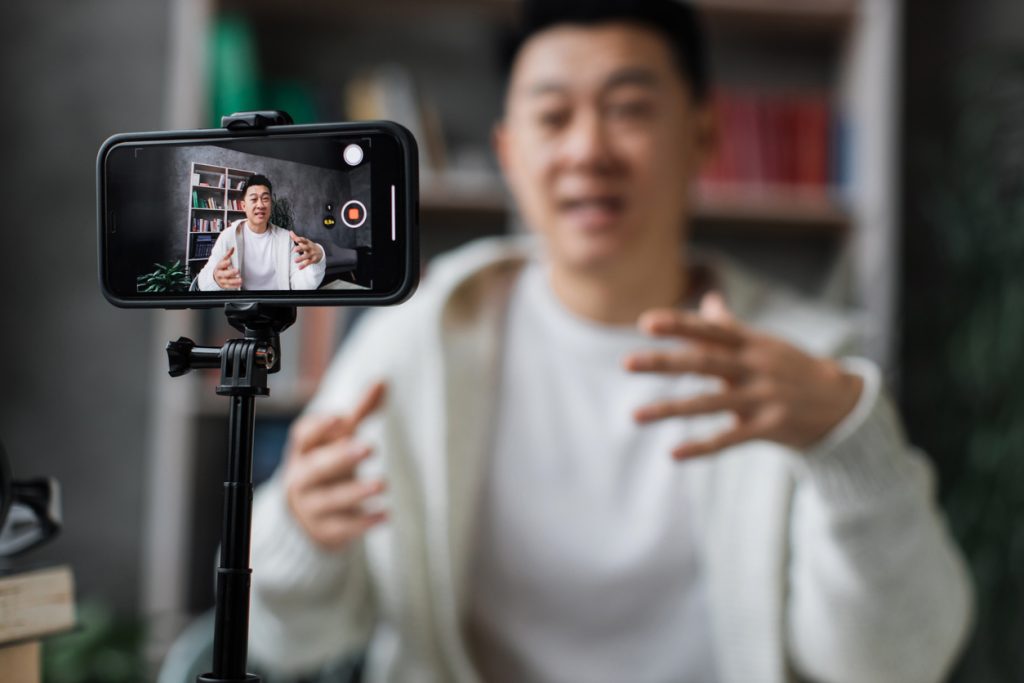How to Speak English Fluently: 17 Misleading Myths That Are Hurting Your Progress

So if you’re feeling shy about your English, or worried about how to get to the next level— don’t worry!
I’m going to bust some common myths around language learning that are stopping you from expressing yourself.
Table of Contents:
- MYTH: English Is Hard
- MYTH: Only Children Can Learn Languages Easily
- MYTH: Some People Are Not Able To Learn a New Language
- MYTH: It Takes a Long Time To Learn a Language
- MYTH: Everyone Learns English Differently
- MYTH: You Must Practice Speaking to Improve Fluency
- MYTH: You Need to Force Yourself to Speak and Make Mistakes
- MYTH: You Need to Record Yourself Speaking
- MYTH: You Need Pronunciation Lessons From an English Teacher
- MYTH: You Need to Learn Single-Word Translations
- MYTH: You Need to Learn More Words
- MYTH: You Need To Learn “Advanced” Vocabulary
- MYTH: You Need a Practice Partner
- MYTH: You Need More “Traditional” Classes
- MYTH: You Need Immersion
- MYTH: You Need to Live in an English-Speaking Country
- MYTH: You Need to Learn 10 New Words a Day
17 Myths to Avoid So You Can Speak Fluent English Sooner
Many people hold misconceptions when it comes to developing English fluency – so let’s address each one and correct them as we go.
1. MYTH: English Is Hard
The truth: Traditional methods make English complex and confusing.
Languages only seem hard to learn because “second language” learning methods make them hard to understand. When you try to memorize grammar rules or learn through translations, of course English becomes confusing.
But when you learn English as a FIRST language, like we’ll show you in this article, you understand things quickly, feel confident about speaking, and become a fluent English speaker faster than most learners think is possible!
2. Myth: Only Children Can Learn Languages Easily
The truth: Adults Have Many Advantages Children Don’t
We have a whole article describing the benefits adults have over children for language learning. But the most important advantage adults have at developing fluency is their ability to choose what, and how, they learn.
Children improve their fluency by getting lots of language exposure over time. They learn about vocabulary, grammar, pronunciation, culture and more, but this is rarely systematic. Sometimes adults don’t explain things well, and children can often go years between hearing something for the first time, and finally understanding what it means.
But adult learners have the ability to use methods that can improve their learning far faster. And if some teacher or method isn’t helping them build fluency, they can always try learning English as a FIRST language.
3. MYTH: Some People Are Not Able To Learn a New Language
The truth: Anyone Can Learn a New Language!
Another unfortunate common misconception is the belief that only certain individuals have the skills to learn a new language while others don’t. This myth often stems from personal experiences or stories of others who found language acquisition challenging.
This myth has also become prevalent because of the belief that people who speak two languages have an easier time learning a new language. While it’s true that learning a second language that shares similar root words and structure with another language can feel comfortable and “easier,” that’s not always the case.
For example, the romance languages French and Spanish share many linguistic structures, but an individual who speaks both may find it harder to learn a language like Mandarin that does not share any of those roots or structures.
But, the truth is we all get fluent the same way: when we understand a language well. And since you do this by learning a new language all in that language, ANYONE can do this.
It’s also important to remember that you ALREADY speak multiple “first languages” fluently. These might all be in one language, but you probably speak differently in casual or professional communication. Or you speak one way to adults, and a different way to children. But you’re able to do this because you learned these different “languages” as first languages. So, you can do the same thing when learning ENGLISH, and become a fluent speaker of English, too!
Sign up for Fluent For Life to get access to the tools you need to become truly fluent in English.
4. MYTH: It Takes a Long Time To Learn a Language
The truth: No, It Doesn’t!
Again, traditional methods make language learning a long and difficult process because these lessons are so much harder to understand.
But once you start learning English as a first language, which you’ll learn more about in this article, you’ll see how fast progress can really be!
5. MYTH: Everyone Learns English Differently
The truth: We all get fluent the same way!
Language learners have many beliefs about personal “learning style,” or methods that they need to get fluent. But the reality is we all get fluent the same way.
Language researchers found that the key to language acquisition is understanding English like a native, because doubt will stop you from expressing yourself. So although you might like learning with music rather than watching TV, you only build fluency when you remove doubts.
This is why EnglshAnyone focuses on making English understandable, with a wide variety of what we call “fluency triggers” that help you learn English like a native.
Click here to learn more about “fluency triggers,” and EnglishAnyone’s Fluent For Life program.
6. MYTH: You Must Practice Speaking to Improve Fluency
The truth: Fluency is a unique skill that requires a surprising kind of practice.
Think about learning to play the guitar…
You practice a chord until it sounds good. You then memorize a series of chords to learn a song. Finally, you repeat this same series again and again until you can play the song automatically.
But language fluency isn’t a skill that you develop through this kind of repetition – real communication is dynamic.
You need to be prepared for varied words and phrases in real-speaking situations. And this is a BIG difference from learning something like an instrument.
Our ability to speak fluently depends on how well we can understand and react to the other person in the conversation.
You must be prepared for the unexpected.
So the surprising method that works better than speaking practice is STAYING SILENT while you get more varied input.
We know from Dr. Stephen Krashen’s work on The Input Hypothesis of Language Acquisition states that fluency emerges on its own as you understand more of a language.
Dr. Krashen found that native children often go through a silent period before they speak. So the best way to get fluent is to simply get comprehensible input (understandable messages, all in English).
Speech is the result that comes when the learner feels ready to open their mouth.
When you understand messages — what the other person is saying — you’ll feel confident, and start speaking without hesitating.
7. MYTH: You Need to Force Yourself to Speak and Make Mistakes
The truth: Forcing yourself to speak before you’re ready can actually hurt your progress.
I can’t overstate this point!
You just learned that silence is important for developing fluency. But here’s another good reason why this quiet period is necessary:
We know from research that anxiety is a barrier to speaking fluently. Worries and doubts about grammar, vocabulary and pronunciation can cause you to hesitate, forget words, and lose confidence when you speak.
If you’ve ever had to speak in an English classroom before you felt ready, you know what this is like.
Remember that “practice” comes from input, not output (speech).
So, here’s a better way to practice so you speak without making mistakes:
Pick a topic that interests you. For example:
- How to do yoga
- How to bake chocolate chip cookies
- How to work out at home
Then, find 3 English language YouTube videos (or videos on other sites) on this subject.
Make sure that each one is from a different person. This allows you to hear a variety of accents, expressions, and idioms that native speakers use.
As you watch each one, you’ll start to notice a little bit more. You’ll naturally learn the correct things to say, and you’ll really feel your confidence developing!
Don’t put pressure on yourself to learn everything at once. Understanding is a process of “layering” new information on old, which makes it more memorable.
Each time you add a layer, you feel more confident because your understanding is growing, making you feel excited and more likely to speak sooner.
8. MYTH: You Need to Record Yourself Speaking
The truth: This might be a helpful way to track your progress over time — like taking photos of yourself as you try to lose weight — but it most likely WON’T improve your fluency.
Think about learning a song you really like. You’d listen to the song over and over again, matching your voice to what you hear.
You might also read the lyrics to understand everything. But you probably wouldn’t record yourself, would you?
So, to become a better English speaker, it’s better to spend your time getting MORE understandable messages. Listening, watching, and reading real spoken English is the best use of your time.
Again, it’s input that automatically develops your listening pronunciation, vocabulary, grammar, and more… to get you fluent as fast as possible.
9. MYTH: You Need Pronunciation Lessons From an English Teacher
The truth: Think about how little kids learn to speak. They hear hundreds of different people growing up. And their pronunciation develops automatically.
So, you can also develop pronunciation skills by hearing a variety of people speaking. These examples can come from radio, TV, online, etc.
Again, conversations are dynamic. So you need to prepare for real speaking situations by hearing MANY different native speakers.
Hearing different speakers like this is one example of what I call Naturally Varied Review.
The more you hear, the better your listening and pronunciation become.
Specifically, hearing the same words pronounced differently, and used in different ways, builds up your understanding and pronunciation skills – one topic at a time.
Keep in mind: There are commonly mispronounced words even among native English speakers. That’s why Naturally Varied Review is so important.
I also created an app called Frederick: Learn To Read to help you improve your English pronunciation, listening and review vocabulary in different ways.
10. MYTH: You Need to Learn Single-Word Translations
The truth: You must learn the nuances of words, all in English.
If you’re translating in your head before you speak, this will slow you down. Translations are also less memorable, and often don’t express what you really want to say.
Instead, focus on learning:
- Phrases for different situations
- And how this same vocabulary can be used in different ways
A fluent speaker can use more than one phrase in a situation. They also know many ways to use the same vocabulary. But you can only develop this skill by learning everything in English.
By studying the phrases used in specific situations, you quickly become more prepared for these situations in real life.
Plus, this approach helps you build a natural-sounding vocabulary, and understand the “flow” of spoken English.
11. MYTH: You Need to Learn More Words
The truth: You should spend more time really understanding FEWER words.
One day, when I was walking through a park in Nagasaki, Japan, I noticed some children FLUENTLY communicating in Japanese. I thought to myself:
“Why are these three-year-olds able to speak so well with their parents when I still can’t say more than a basic sentence? I’ve been studying hard for a year already!”
It’s very common for native children to speak better than adult English learners who may know many words.
This is because children spend more time getting the right input, and really MASTERING this vocabulary.
What’s happening is children are spending a LOT of time reviewing a smaller amount of words until they really feel confident about them. THEN children expand to more advanced things.
Remember – even if you know EVERY word, you still won’t speak if you lack the confidence to use them correctly and automatically.
As Bruce Lee said, “I fear not the man who has practiced 10,000 kicks once, but I fear the man who has practiced one kick 10,000 times.”
12. MYTH: You Need To Learn “Advanced” Vocabulary
The truth: Correct, fluent speech is much more useful – and impressive – than advanced vocabulary spoken without confidence or incorrectly.
Those children in the park only had a basic vocabulary, yet… they were speaking fluently!
English students are always excited to learn more advanced words and phrases, but I always tell them:
“If you don’t feel confident making basic sentences, and without hesitation, spend more time getting basic input before adding more vocabulary.”
Fluency is measured by how well you speak, not how many words you know. So review the basics in different ways until they’re automatic for you.
13. MYTH: You Need a Practice Partner
The truth: Fluency is built with the input of MANY different speakers, not by you speaking.
If you don’t feel confident, and you’re not ready to speak, forcing yourself ISN’T necessary.
It’s more important to continue getting native input that you understand.
This input can come from:
- Reading magazines, books, articles online, etc.
- Listening to podcasts, music, videos, etc.
- Watching TV shows, news, movies, etc.
The point is to get native content that you can understand.
However, if you DO feel confident enough to speak…
Here’s How to Speak With Native Speakers:
The trick is to think like a native.
Instead of looking for a “practice partner,” find someone who shares your interests.
Speak about a topic (in English) that interests both of you. It’s way more fun, and that’s how native speakers “practice speaking.”
NEVER ask a native speaker to “practice English” with you.
This puts a lot of pressure on them, and they might feel unprepared or overwhelmed.
It can also feel like work instead of fun.
So spend your time speaking in English, and connecting with them, rather than trying to do a “lesson” or language exchange.
Just be sure to pay attention to how they describe things because this input is what really develops your fluency!
If you KNOW a lot of English, but struggle to SPEAK...
14. MYTH: You Need More “Traditional” Classes
The truth: You must stop studying English, and start experiencing English like a native.
When we’re struggling to speak fluently, it’s common to think:
“I NEED to take more classes!”
But these lessons will probably only help you:
- Memorize more vocabulary and grammar rules, rather than USE correct English without thinking
- Study translations and definitions, not understanding English like a native
- Practice speaking, instead of getting more native input
Research has shown that this method is NOT the best way to learn how to SPEAK fluently. But you probably know this already, if you’ve been learning for years and still can’t speak as well as you’d like.
Traditional classes can also develop bad habits, like needing to organize sentences in your head before speaking.
Instead, you must learn English as a FIRST language, by connecting vocabulary with situations, rather than connecting English with translations in your native language.
This is what we help you do at EnglishAnyone, and it’s what makes us unique.
15. MYTH: You Need Immersion
The truth: An English environment won’t help you if you aren’t systematically getting understandable messages.
The idea of this myth is to “surround yourself with English.” People normally do this in a few ways:
- Changing the language on your phone/computer/tablet
- Watching English movies
- Listening to songs and podcasts
- Taking classes in English
I don’t know about you… but changing the language on my phone and laptop makes me nervous. And it can overwhelm you with too many things you can’t understand, especially if you need to change something in “settings.”
No thanks.
Watching movies and listening to podcasts can be helpful and entertaining. But it’s important to remember that you should understand at least 80-90% of any content you consume. This way, you learn new things in context, like a native.
If you don’t understand things, frustration can demotivate you.
Even worse, most people will watch a movie or TV show and never review it in any way.
So many English learners never develop more than a passive vocabulary because they don’t know English as well as they think they do. This means they might understand words they hear, but be unable to use them spontaneously and easily in conversations.
REMEMBER: You must REVIEW what you learn or all of the movies and English environments in the world won’t help you.
The truth is even 15 minutes of varied understandable lessons will help you improve faster than hours in a traditional class because it’s the right input that builds fluency.
Understandable native content is the key. Each time you get understandable input, you feel yourself becoming a little more fluent… even if you don’t speak.
16. MYTH: You Need to Live in an English-Speaking Country
The truth: HOW you learn is far more important than WHERE you learn.
Traveling to another country can be a lot of fun. In fact, it’s one of the best experiences you can give yourself as a language learner.
But when it comes to learning to speak fluently, it’s not the guarantee that most people think it is.
I know this because:
- I had a lot of trouble communicating even after living in Japan for a year.
- English students can live in English-speaking countries for years and still struggle to express themselves. Many of my students who live in English-speaking countries found me after experiencing communication problems for 10 years or more!
Like immersion, a native environment can be overwhelming.
Research by Dr. Krashen shows that living in a native country helps most when you already have a good ability to speak (so intermediate level or better).
And even if you take English classes while living in an English-speaking country, these will probably only give you more of the same traditional lessons that STOP you from speaking.
The truth is you only need native INPUT, not actual native speakers.
So, you can become fluent ANYWHERE, by yourself!
17. MYTH: You Need to Learn 10 New Words a Day
The truth: It’s better to learn ONE word until you can use it fluently, then learn more.
I know you’re probably in a hurry to get fluent… but learning 10 random words each day typically slows learners down.
Instead, I recommend learning one word or phrase VERY WELL. One leg at a time.
The goal is to focus on learning one new concept or phrase a day, and master using it in different contexts. This is what quickly expands your vocabulary and speaking confidence because you know how to use one thing in many different situations.
Do this, and you’ll be able to use a word or expression in almost any conversation, regardless of the topic. You’ll also remember words more easily with this approach.
There’s Only One Way to Speak English Fluently
Your ability to speak is the result of understanding English like a native. So the more understandable lessons you get, the faster you’ll get fluent.
When in doubt, ask yourself what a native speaker would do.
Would a native speaker use translations and study rules, or try to really understand vocabulary and grammar by experiencing them in all English, and in different situations?
You now know the 17 myths that aren’t helping you – and what to do instead!
If you want a proven system to follow so you can feel prepared for real conversations, and have a proven roadmap to fluency, then check out Fluent For Life.
Additional English Language Learning Articles:
How to Get Fluent Without Living in an English-Speaking Country
“One Leg At A Time” – The Secret to Motivation and English Fluency







